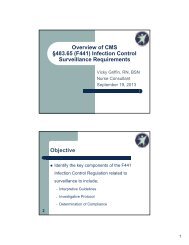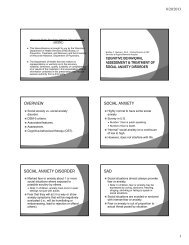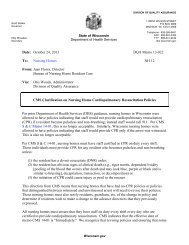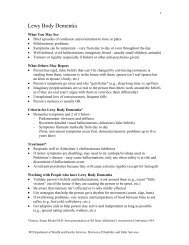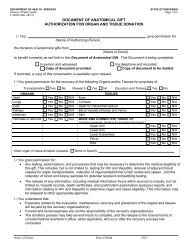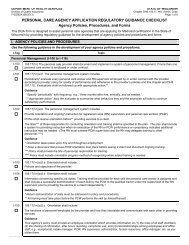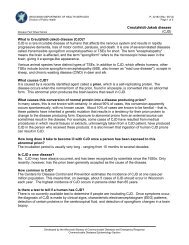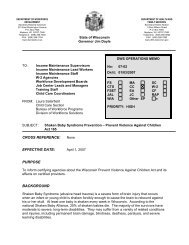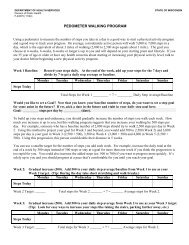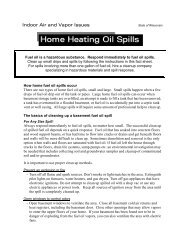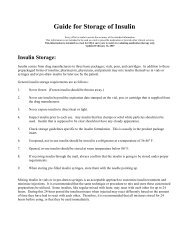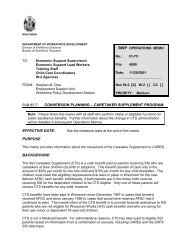Halcion - Wisconsin Department of Health Services
Halcion - Wisconsin Department of Health Services
Halcion - Wisconsin Department of Health Services
You also want an ePaper? Increase the reach of your titles
YUMPU automatically turns print PDFs into web optimized ePapers that Google loves.
DEPARTMENT OF HEALTH SERVICES<br />
Division <strong>of</strong> Mental <strong>Health</strong> and Substance Abuse <strong>Services</strong><br />
F-24277 (12/2010)<br />
INFORMED CONSENT FOR MEDICATION<br />
Dosage and / or Side Effect information last revised on 12/17/2010<br />
STATE OF WISCONSIN<br />
42 CFR483.420(a)(2)<br />
DHS 134.31(3)(o)<br />
DHS 94.03 & 94.09<br />
s.51.61(1)(g) & (h)<br />
Completion <strong>of</strong> this form is voluntary. If not completed, the medication cannot be administered without a court order unless in an emergency.<br />
This consent is maintained in the client’s record and is accessible to authorized users.<br />
Name – Patient / Client (Last, First, MI) ID Number Living Unit Birthdate<br />
Name – Individual Preparing This Form Name – Staff Contact Name / Telephone Number – Institution<br />
MEDICATION CATEGORY MEDICATION RECOMMENDED<br />
DAILY TOTAL DOSAGE RANGE<br />
Sedative, Hypnotic<br />
<strong>Halcion</strong><br />
0.125 - 0.25mg<br />
(triazolam)<br />
ANTICIPATED<br />
DOSAGE<br />
RANGE<br />
The anticipated dosage range is to be individualized, may be above or below the recommended range but no medication will be administered<br />
without your informed and written consent.<br />
Recommended daily total dosage range <strong>of</strong> manufacturer, as stated in Physician’s Desk Reference (PDR) or another standard reference.<br />
This medication will be administered Orally Injection Other – Specify:<br />
1. Reason for Use <strong>of</strong> Psychotropic Medication and Benefits Expected (note if this is ‘Off Label’ Use)<br />
Include DSM IV diagnosis or the diagnostic “working hypothesis.”<br />
2. Alternative mode(s) <strong>of</strong> treatment other than or in addition to medications include<br />
Note: Some <strong>of</strong> these would be applicable only in an inpatient environment.<br />
-Environment and / or staff changes<br />
-Rehabilitation treatments / therapy (OT, PT, AT)<br />
-Positive redirection and staff interaction<br />
-Treatment programs and approaches (habilitation)<br />
-Individual and / or group therapy<br />
-Use <strong>of</strong> behavior intervention techniques<br />
Other Alternatives:<br />
3. Probable consequences <strong>of</strong> NOT receiving the proposed medication are<br />
Impairment <strong>of</strong> -Work Activities -Family Relationships -Social Functioning<br />
Possible increase in symptoms leading to potential<br />
-Use <strong>of</strong> seclusion or restraints<br />
-Limits on access to possessions<br />
-Limits on personal freedoms<br />
-Limit participation in treatment and activities<br />
Other consequences<br />
-Limits on recreation and leisure activities<br />
-Intervention <strong>of</strong> law enforcement authorities<br />
-Risk <strong>of</strong> harm to self or others<br />
Note: These consequences may vary, depending upon whether or not the individual is in an inpatient setting. It is also possible that in<br />
unusual situations, little or no adverse consequences may occur if the medications are not administered.<br />
See Page 2<br />
Client Initial Date
F-24277 Page 2 Medication : <strong>Halcion</strong> - (triazolam)<br />
4. Possible side effects, warnings and cautions associated with this medication are listed below. This is not an all inclusive list but is<br />
representative <strong>of</strong> items <strong>of</strong> potential clinical significance to you. For more information on this medication, you may consult further with your<br />
physician or refer to a standard text such as the PDR or the United States Pharmacopoeia Dispensing Information (USPDI). As part <strong>of</strong><br />
monitoring some <strong>of</strong> these potential side effects, your physician may order laboratory or other tests. The treatment team will closely monitor<br />
individuals who are unable to readily communicate side effects, in order to enhance care and treatment.<br />
Continued – Possible side effects, warnings and cautions associated with this medication.<br />
More common side effects include: Clumsiness or unsteadiness; dizziness or lightheadedness; drowsiness; slurred speech.<br />
Check with your doctor as soon as possible if any <strong>of</strong> the following less common side effects occur: Anxiety; confusion (may be more common<br />
in the elderly); fast, pounding, or irregular heartbeat; lack <strong>of</strong> memory <strong>of</strong> events taking place after benzodiazepine is taken (may be more<br />
common with triazolam; mental depression.<br />
Other less common or rare side effects include: Abdominal or stomach cramps or pain; blurred vision or other changes in vision; changes in<br />
sexual desire or ability; constipation; diarrhea; dryness <strong>of</strong> mouth or increased thirst; false sense <strong>of</strong> well-being; headache; increased bronchial<br />
secretions or watering <strong>of</strong> mouth; muscle spasm; nausea or vomiting; problems with urination; trembling or shaking; unusual tiredness or<br />
weakness.<br />
Check with your doctor as soon as possible if any <strong>of</strong> the following rare side effects occur: Abnormal thinking, including disorientation,<br />
delusions (holding false beliefs that cannot be changed by facts), or loss <strong>of</strong> sense <strong>of</strong> reality; agitation; behavior changes, including aggressive<br />
behavior, bizarre behavior, decreased inhibition, or outbursts <strong>of</strong> anger; convulsions (seizures); hallucinations (seeing, hearing, or feeling<br />
things that are not there); hypotension (low blood pressure); muscle weakness; skin rash or itching; sore throat, fever, and chills; trouble in<br />
sleeping; ulcers or sores in mouth or throat (continuing); uncontrolled movements <strong>of</strong> body, including the eyes; unusual bleeding or bruising;<br />
unusual excitement, nervousness, or irritability; unusual tiredness or weakness (severe); yellow eyes or skin.<br />
WARNINGS<br />
Triazolam is a federally controlled substance (C-IV) because it can be abused or lead to dependence. Keep triazolam in a safe place to<br />
prevent misuse and abuse. Selling or giving away trizolam may harm others, and is against the law. Tell your doctor if you have ever abused<br />
or been dependent on alcohol, prescription medicines or street drugs.<br />
Because sleep disturbances may be the presenting manifestation <strong>of</strong> a physical and/or psychiatric disorder, symptomatic treatment <strong>of</strong> insomnia<br />
should be initiated only after a careful evaluation <strong>of</strong> the patient. The failure <strong>of</strong> insomnia to remit after 7 to 10 days <strong>of</strong> treatment may indicate<br />
the presence <strong>of</strong> a primary psychiatric and/or medical illness that should be evaluated. Worsening <strong>of</strong> insomnia or the emergence <strong>of</strong> new<br />
thinking or behavior abnormalities may be the consequence <strong>of</strong> an unrecognized psychiatric or physical disorder. Such findings have emerged<br />
during the course <strong>of</strong> treatment with sedative-hypnotic drugs. Because some <strong>of</strong> the important adverse effects <strong>of</strong> sedative-hypnotics appear to<br />
be dose related, it is important to use the smallest possible effective dose, especially in the elderly.<br />
Complex behaviors such as "sleep-driving" (i.e., driving while not fully awake after ingestion <strong>of</strong> a sedative-hypnotic, with amnesia for the<br />
event) have been reported. These events can occur in sedative-hypnotic-naïve as well as in sedative-hypnotic-experienced persons. Although<br />
behaviors such as sleep-driving may occur with sedative-hypnotics alone at therapeutic doses, the use <strong>of</strong> alcohol and other CNS depressants<br />
with sedative-hypnotics appears to increase the risk <strong>of</strong> such behaviors, as does the use <strong>of</strong> sedative-hypnotics at doses exceeding the<br />
maximum recommended dose. Due to the risk to the patient and the community, discontinuation <strong>of</strong> sedative-hypnotics should be strongly<br />
considered for patients who report a "sleep-driving" episode. Other complex behaviors (e.g., preparing and eating food, making phone calls, or<br />
having sex) have been reported in patients who are not fully awake after taking a sedative-hypnotic. As with sleep-driving, patients usually do<br />
not remember these events.<br />
Central nervous system manifestations: An increase in daytime anxiety has been reported for triazolam after as few as 10 days <strong>of</strong><br />
continuous use. In some patients this may be a manifestation <strong>of</strong> interdose withdrawal. If increased daytime anxiety is observed during<br />
treatment, discontinuation <strong>of</strong> treatment may be advisable. A variety <strong>of</strong> abnormal thinking and behavior changes have been reported to occur in<br />
association with the use <strong>of</strong> benzodiazepine hypnotics including triazolam. Some <strong>of</strong> these changes may be characterized by decreased<br />
inhibition, e.g., aggressiveness and extroversion that seem excessive, similar to that seen with alcohol and other CNS depressants (e.g.,<br />
sedative/hypnotics). Other kinds <strong>of</strong> behavioral changes have also been reported, for example, bizarre behavior, agitation, hallucinations,<br />
depersonalization. In primarily depressed patients, the worsening <strong>of</strong> depression, including suicidal thinking, has been reported in association<br />
with the use <strong>of</strong> benzodiazepines. It can rarely be determined with certainty whether a particular instance <strong>of</strong> the abnormal behaviors listed<br />
above is drug induced, spontaneous in origin, or a result <strong>of</strong> an underlying psychiatric or physical disorder. Nonetheless, the emergence <strong>of</strong> any<br />
new behavioral sign or symptom <strong>of</strong> concern requires careful and immediate evaluation. Because <strong>of</strong> its depressant CNS effects, patients<br />
receiving triazolam should be cautioned against engaging in hazardous occupations requiring complete mental alertness such as operating<br />
machinery or driving a motor vehicle. For the same reason, patients should be cautioned about the concomitant ingestion <strong>of</strong> alcohol and other<br />
CNS depressant drugs during treatment with triazolam. As with some, but not all benzodiazepines, anterograde amnesia <strong>of</strong> varying severity<br />
and paradoxical reactions have been reported following therapeutic doses <strong>of</strong> triazolam. Data from several sources suggest that anterograde<br />
amnesia may occur at a higher rate with HALCION than with other benzodiazepine hypnotics.<br />
See PDR, USPDI or US Hospital Formulary Service for all-inclusive list <strong>of</strong> side effects.<br />
Client Initial Date
F-24277 Page 3<br />
Medication : <strong>Halcion</strong> - (triazolam)<br />
By my signature below, I GIVE consent for the named medication on Page 1 and anticipated dosage range. My signature also<br />
indicates that I understand the following:<br />
1. I can refuse to give consent or can withdraw my consent at any time with written notification to the institution director or designee. This<br />
will not affect my right to change my decision at a later date. If I withdraw consent after a medication is started, I realize that the<br />
medication may not be discontinued immediately. Rather it will be tapered as rapidly as medically safe and then discontinued so as to<br />
prevent an adverse medical consequence, such as seizures, due to rapid medication withdrawal.<br />
2. Questions regarding this medication can be discussed with the Interdisciplinary Team, including the physician. The staff contact person<br />
can assist in making any necessary arrangements.<br />
3. Questions regarding any behavior support plan or behavior intervention plan, which correspond with the use <strong>of</strong> the medication, can be<br />
directed to the client’s social worker, case manager or psychologist.<br />
4. I have the right to request a review at any time <strong>of</strong> my record, pursuant to ss. 51.30(4)(d) or 51.30(5)(b).<br />
5. I have a legal right to file a complaint if I feel that client rights have been inappropriately restricted. The client’s social worker, case<br />
manager or agency / facility client rights specialist may be contacted for assistance.<br />
6. My consent permits the dose to be changed within the anticipated dosage range without signing another consent.<br />
7. I understand the reasons for the use <strong>of</strong> the medication, its potential risks and benefits, other alternative treatment(s) and the probable<br />
consequences, which may occur if the proposed medication is not given. I have been given adequate time to study the information and<br />
find the information to be specific, accurate and complete.<br />
8. This medication consent is for a period effective immediately and not to exceed fifteen (15) months from the date <strong>of</strong> my signature. The<br />
need for and continued use <strong>of</strong> this medication will be reviewed at least quarterly by the Interdisciplinary Team. The goal, on behalf <strong>of</strong> the<br />
client, will be to arrive at and maintain the client at the minimum effective dose.<br />
SIGNATURES<br />
DATE SIGNED<br />
Client – If Presumed Competent to Consent/Parent <strong>of</strong> Minor/Guardian (POA-HC) Relationship to Client Self<br />
Parent Guardian (POA-HC)<br />
Staff Present at Oral Discussion<br />
Title<br />
Client / Parent <strong>of</strong> Minor / Guardian (POA-HC) Comments<br />
As parent/guardian (POA-HC) was not available for signature, he/she was verbally informed <strong>of</strong> the information in this consent.<br />
Verbal Consent<br />
Obtained by – PRINT – Staff Name Date Obtained Written Consent Received<br />
Obtained from – PRINT – Parent / Guardian (POA-HC) Name Date Expires Date Received<br />
Client Initial Date



